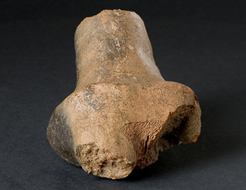|
||||||||||||||||||||||||||||||||
|
|
Museum of: Rome | |||||||||||||||||||||||||||||||
| Name of the artefact: Statuette of Favella | ||||||||||||||||||||||||||||||||
|
From the Early Neolithic village of Favella comes a set
of pottery statuettes with a special emphasis on the sexual aspects of the
motherhood. The focus on genitalia resembles clearly the ‘Pregnant
Vegetation Goddes’ as defined by M. Gimbutas |
||||||||||||||||||||||||||||||||
|
WHERE IS IT AND MAIN
CHARACTERISTICS |
STATE |
|||||||||||||||||||||||||||||||
|
Department: |
- |
Preservation: |
Good | |||||||||||||||||||||||||||||
|
Inventory number: |
- |
Restauration: |
Restored | |||||||||||||||||||||||||||||
|
Name of the artefact: |
Statuette of Favella |
Completeness: |
Incomplete | |||||||||||||||||||||||||||||
|
Object type: |
Human figurine |
|||||||||||||||||||||||||||||||
|
Material: |
Ceramics |
|||||||||||||||||||||||||||||||
|
Methof of manufacture: |
Hand craft |
|||||||||||||||||||||||||||||||
|
Decoration
type: |
Incision |
|||||||||||||||||||||||||||||||
|
Distinctive mark: |
- |
|||||||||||||||||||||||||||||||
|
DIMENSIONS |
PERIOD OF USE |
|||||||||||||||||||||||||||||||
|
Length (mm): |
- |
Epoque: |
Neolithic |
|||||||||||||||||||||||||||||
|
Heigth
(mm): |
122 |
Culture: |
- |
|||||||||||||||||||||||||||||
|
Diameter
(mm): |
- |
Period: |
Early Neolithic |
|||||||||||||||||||||||||||||
|
Width (mm): |
95 |
Face: |
- |
|||||||||||||||||||||||||||||
|
Thickness (mm): |
- |
Absolute chronology: |
6900 BP |
|||||||||||||||||||||||||||||
|
Weight
(g): |
- |
|||||||||||||||||||||||||||||||
DISCOVERY |
||||||||||||||||||||||||||||||||
|
Date: |
2002 |
Country: |
Italy |
|||||||||||||||||||||||||||||
|
District: |
Calabria |
Town hall affiliation: |
Cosenza |
|||||||||||||||||||||||||||||
|
Village: |
Corigliano |
Discovery findspot: |
Favella |
|||||||||||||||||||||||||||||
|
Condition of discovery: |
Archaeological excavation |
Discovery type: |
Deposit |
|||||||||||||||||||||||||||||
|
ANALYSES – DETERMINATIONS |
FILLED IN BY |
|||||||||||||||||||||||||||||||
|
Type: |
- |
Name: |
Chiara Delpino, Vincenzo Tinè |
|||||||||||||||||||||||||||||
|
Laboratory: |
- |
Institution: |
- |
|||||||||||||||||||||||||||||
|
No./Code: |
- |
Date: |
10-2005 |
|||||||||||||||||||||||||||||
|
DEEPENINGS |
||||||||||||||||||||||||||||||||
|
Morphology of the object: |
||||||||||||||||||||||||||||||||
|
The statuette representing a female figure was
recovered mutilated at the basin level. The sexual-attributes are
emphazised by the engraved representation of the female’s genitalia and of
a large bottom. The statuette has a standing posture, as shown by the
position of the left legs. |
||||||||||||||||||||||||||||||||
|
Decoration: |
||||||||||||||||||||||||||||||||
|
- |
||||||||||||||||||||||||||||||||
|
Inscription: |
||||||||||||||||||||||||||||||||
|
- |
||||||||||||||||||||||||||||||||
|
Analogies: |
||||||||||||||||||||||||||||||||
|
The statuette belongs to a broader group of figurines
from the same site of Favella and to others of the same facies (as from
Rendina) completing the iconographic knowledge on this kind of artefacts.
The fragmentary state of the other figurines lacked the upper part of the
bodies. The lower part of the bodies of the other statuettes recovered
show a seated or crouched position (typical of a large Neolithical
Cultural area which extends from the Near East regions to the Balkans and
the Aegean) that can easily be linked to birth. Usually emphasized by the
female’s genitalia dilatation positioned in the lower part of the seated
body instead of in the pubic area. Other examples seem to depict standing
figures, with genitalia emphasized by its disproportionate size
representations. Recently another statuette was recovered at Favella
settlement: this figure, which is preserved from the wasi level, shows us
the resemblance of the upper part of the statuettes’ body. The Favella
figurine also bears generic resemblance to many typologies of female
images common in the Neolithic Period in Italy: it is an old and
widespread kind of iconography in regard to its main characteristics. It
is however possible to determine some patterns linked to specific cultural
spheres even if difficult to perceive because of the rareness of the
finds. Proof of the cult of mother-goddess with marked naturalistic
features have been found in the South-East region of Italy (Favella and
Rendina) within the Early Neolithic Period. While figurines from the
Adriatic- Central Italy area (middle culture Adriatic) have schematic
features( as in Monterado). The statuette belongs to a broader group of
figurines from the same site of Favella and to others of the same facies
(as from Rendina) completing the iconographic knowledge on this kind of
artefacts. The fragmentary state of the other figurines lacked the upper
part of the bodies. The lower part of the bodies of the other statuettes
recovered show a seated or crouched position (typical of a large
Neolithical Cultural area which extends from the Near East regions to the
Balkans and the Aegean) that can easily be linked to birth. Usually
emphasized by the female’s genitalia dilatation positioned in the lower
part of the seated body instead of in the pubic area. Other examples seem
to depict standing figures, with genitalia emphasized by its
disproportionate size representations. Recently another statuette was
recovered at Favella settlement: this figure, which is preserved from the
wasi level, shows us the resemblance of the upper part of the statuettes’
body. The Favella figurine also bears generic resemblance to many
typologies of female images common in the Neolithic Period in Italy: it is
an old and widespread kind of iconography in regard to its main
characteristics. It is however possible to determine some patterns linked
to specific cultural spheres even if difficult to perceive because of the
rareness of the finds. Proof of the cult of mother-goddess with marked
naturalistic features have been found in the South-East region of Italy
(Favella and Rendina) within the Early Neolithic Period. While figurines
from the Adriatic- Central Italy area (middle culture Adriatic) have
schematic features( as in Monterado). |
||||||||||||||||||||||||||||||||
|
Interpretation: |
||||||||||||||||||||||||||||||||
|
The figurine belongs to the motif of seated or standing
female figures with emphasized sexual- attributes, known in the early
facies of the Italian Neolithic Period. Neolithic art is mainly
characterized by female statuettes, common in most continental and
Mediterranean areas of Europe, the Balkans and the Aegean, while male and
animal figurines are fewer in numbers. Compared to the statuettes of the
“Venus” from the Upper Paleolithic Period some representation themes
persist, such as the aspect of female fertility. Thanks to the new forage
economy during the Neolithic Period a stronger link to the fertility of
the earth seems to be mentioned. The location of the find, and probably
the context of use of the object, suggests a use connected to domestic
structures. The icon, or talisman, as a representation of a divine power
protector of the inhabitation or the family usually befell the same fate
of the structure and is found in its debris levels. Other statuettes were
instead positioned under the hut floor during the foundation ritual
|
||||||||||||||||||||||||||||||||
|
Bibliography: |
||||||||||||||||||||||||||||||||
|
CIPOLLONI SAMPÒ M., 1982, Scavi nel villaggio neolitico
di Rendina (1970-‘76). Relazione preliminare. Origini, XI, pp.183-323 TINÈ
S., TINÈ V., TRAVERSO A., 1994, Il villaggio di Favella della Corte e la
neolitizzazione della Sibaritide, Atti XXXII Convegno di Studi della Mgna
Grecia, Taranto 1992, pp.85-102 TINÈ V., (a cura di), 1996, Forme e tempi
della neolitizzazione in Italia meridionale ed in Sicilia, Atti del
seminario, Rossano Calabro 1994 TINÈ V., 2002A, Il Neolitico in Calabria,
Atti XXXVII Riunione Scientifica Istituto Italiano di Preistoria e
Protostoria, pp.115-143. TINÈ V., 2002B, Il Neolitico, in Donne, Uomini e
animali. Oggetti di arte e di culto nella preistoria. Catalogo della
mostra - Roma, Museo “L.Pigorini” 2001 TINÈ V., NATALI E., STARNINI E.,
2000, Il villaggio neolitico antico I di Favella (Cosenza), in PESSINA A.,
MUSCIO G., (a cura di), La neolitizzazione tra Oriente e Occidente, Atti
Convegno di Udine 1999. |
||||||||||||||||||||||||||||||||

